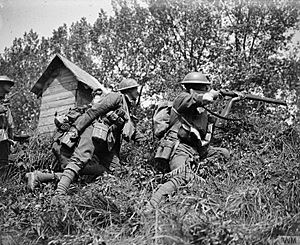Third Battle of the Aisne facts for kids
Quick facts for kids Third Battle of the Aisne |
|||||||||
|---|---|---|---|---|---|---|---|---|---|
| Part of the Western Front of World War I | |||||||||
 The Western Front, July 1918 |
|||||||||
|
|||||||||
| Belligerents | |||||||||
| Commanders and leaders | |||||||||
| Strength | |||||||||
| French 6th Army, British IX Corps and later 2 American Divisions | German 1st and 7th Armies (over 20 divisions and 4,000 artillery guns) | ||||||||
| Casualties and losses | |||||||||
| 127,000 | 130,000 | ||||||||
The Third Battle of the Aisne was a major battle during World War I. It was part of a series of attacks by Germany in 1918. These attacks were known as the Kaiserschlacht. The main goal for Germany was to capture the Chemin des Dames Ridge. They wanted to do this before many American soldiers arrived in France.
Why the Battle Happened
The German attack was a huge surprise. It was called Blücher-Yorck. It started on May 27, 1918, and lasted until June 4. This was the first big German attack after the Lys Offensive in April.
The Germans had held the Chemin des Dames Ridge from 1914 until 1917. Then, French General Mangin captured it during the Second Battle of the Aisne.
General Erich Ludendorff planned the Blücher-Yorck attack. He was a very important German army leader. Ludendorff believed that winning at the Aisne would bring German armies close to Paris. He thought this would make the Allies move their troops away from another important area called Flanders. This would then make it easier for Germany to attack Flanders later. So, the Aisne attack was mostly a trick to draw Allied forces away.
General Denis Auguste Duchêne was in charge of defending the Aisne area. He commanded the French Sixth Army. Four British divisions were also there. They were part of the British IX Corps, led by Lieutenant-General Sir Alexander Hamilton-Gordon. These British troops were resting after fighting in the "Michael" battle.
How the Battle Unfolded
On May 27, 1918, the Germans started their attack. They began by firing over 4,000 artillery guns at the Allied lines. This was a very strong bombardment. The British soldiers suffered many losses. This was because General Duchene did not want to give up the Chemin des Dames ridge. He had ordered the British troops to gather closely in the front trenches. This made them easy targets for the German artillery.
After the shelling, the Germans used poison gas. Once the gas cleared, 17 German Sturmtruppen divisions attacked. These elite troops were part of an army group led by Crown Prince Wilhelm. Even Kaiser Wilhelm II came to see how the battle was going. He met a captured British general and was amused to learn he was Welsh, like Lloyd George.
The Allies were completely surprised. Their defenses were spread out and weak. The German army quickly broke through a 40 kilometres (25 mi) gap in the Allied lines. In less than six hours, they reached the Aisne River. The Germans pushed back eight Allied divisions. They gained an extra 15 km of land by the end of the first day.
The Germans advanced very quickly. By May 30, 1918, they had captured over 50,000 Allied soldiers and more than 800 guns. This made Ludendorff change his plan. He decided to push the attack even further. The German armies came within 56 kilometres (35 mi) of Paris by June 3. However, they then faced many problems. They had many casualties, not enough fresh troops, and supply shortages.
After many counter-attacks by the Allies, the German advance finally stopped three days later.
What Happened After the Battle
The Germans pushed about 34 miles (55 km) into Allied lines. They came closer to Paris than at any time since 1914. But the Allies successfully stopped them at the Marne River on June 6, 1918. By the end of the battle, Germany had about 130,000 casualties. The Allies had about 127,000 casualties.
General Duchene was removed from his command. This was because he handled the British and French troops poorly. Philippe Petain, the French Commander-in-Chief, replaced him with Jean Degoutte. This battle was also important because it was one of the first times a good number of American troops fought. They showed they could fight well.
Ludendorff was encouraged by how much land they gained. He launched more attacks after this battle. These attacks led to the Second Battle of the Marne.
See also
- Chemin des Dames Ridge


